Leadership and Management Strategies for Conflict Resolution Scenarios
VerifiedAdded on 2023/06/10
|8
|1800
|262
Essay
AI Summary
This essay discusses conflict management within a clinical setting, drawing upon a personal placement experience where a workplace conflict impacted the student's performance and learning opportunities. It analyzes the situation using conflict resolution models, particularly focusing on the win-win approach by Eleanor Shakiba. The essay emphasizes the importance of effective conflict management for maintaining workplace relationships, ensuring patient safety, and promoting professional growth. The student reflects on how understanding conflict dynamics and applying collaborative solutions can lead to better outcomes in healthcare management and leadership.
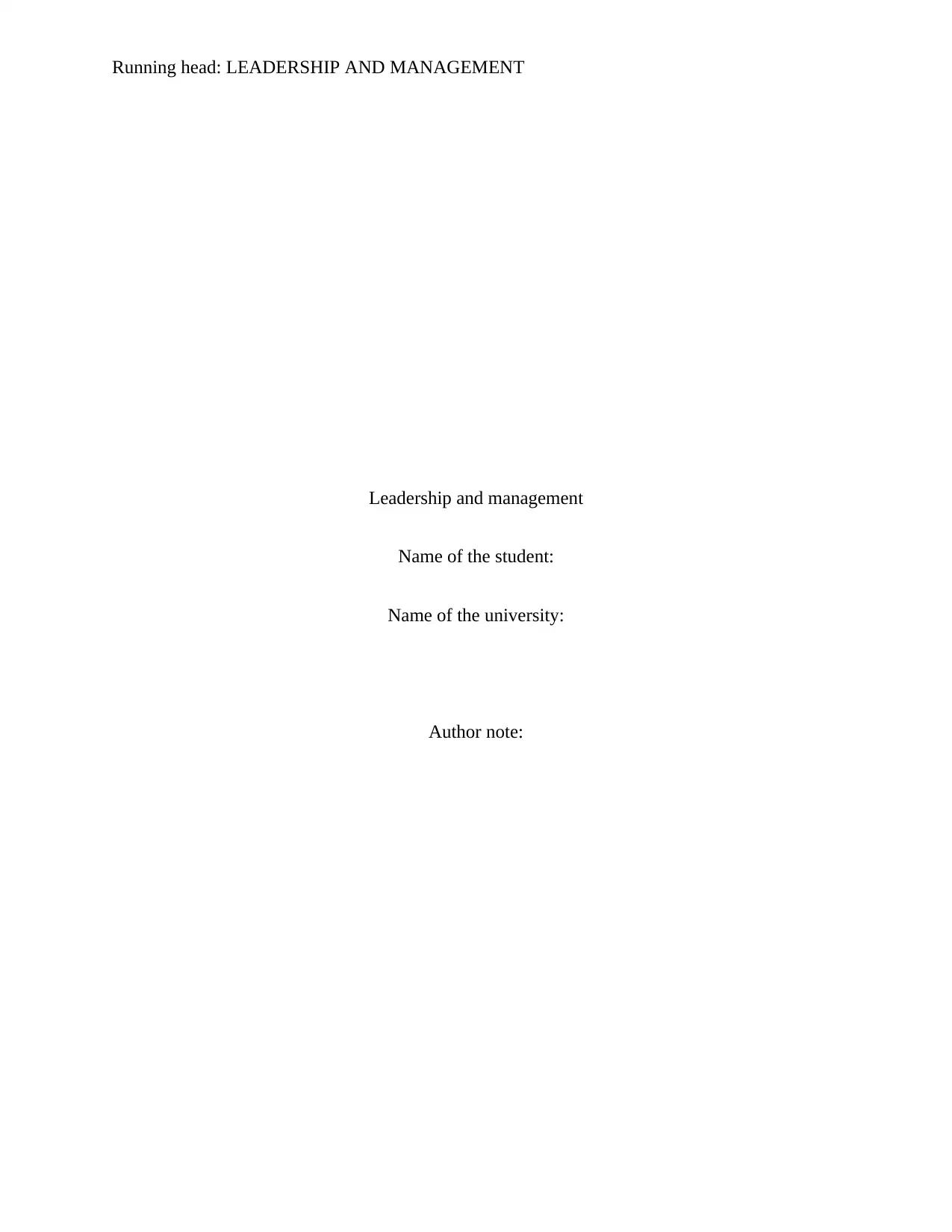
Running head: LEADERSHIP AND MANAGEMENT
Leadership and management
Name of the student:
Name of the university:
Author note:
Leadership and management
Name of the student:
Name of the university:
Author note:
Paraphrase This Document
Need a fresh take? Get an instant paraphrase of this document with our AI Paraphraser
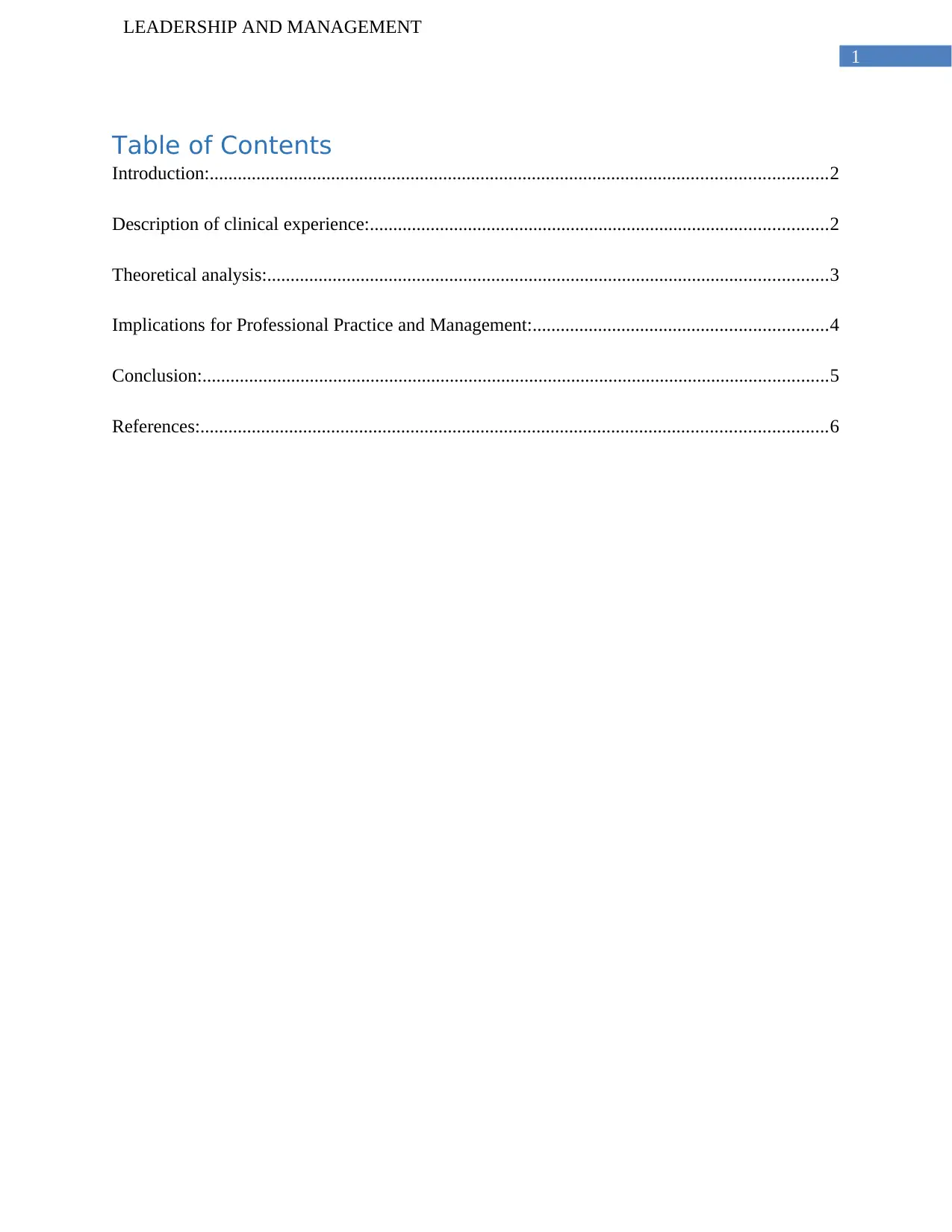
1
LEADERSHIP AND MANAGEMENT
Table of Contents
Introduction:....................................................................................................................................2
Description of clinical experience:..................................................................................................2
Theoretical analysis:........................................................................................................................3
Implications for Professional Practice and Management:...............................................................4
Conclusion:......................................................................................................................................5
References:......................................................................................................................................6
LEADERSHIP AND MANAGEMENT
Table of Contents
Introduction:....................................................................................................................................2
Description of clinical experience:..................................................................................................2
Theoretical analysis:........................................................................................................................3
Implications for Professional Practice and Management:...............................................................4
Conclusion:......................................................................................................................................5
References:......................................................................................................................................6
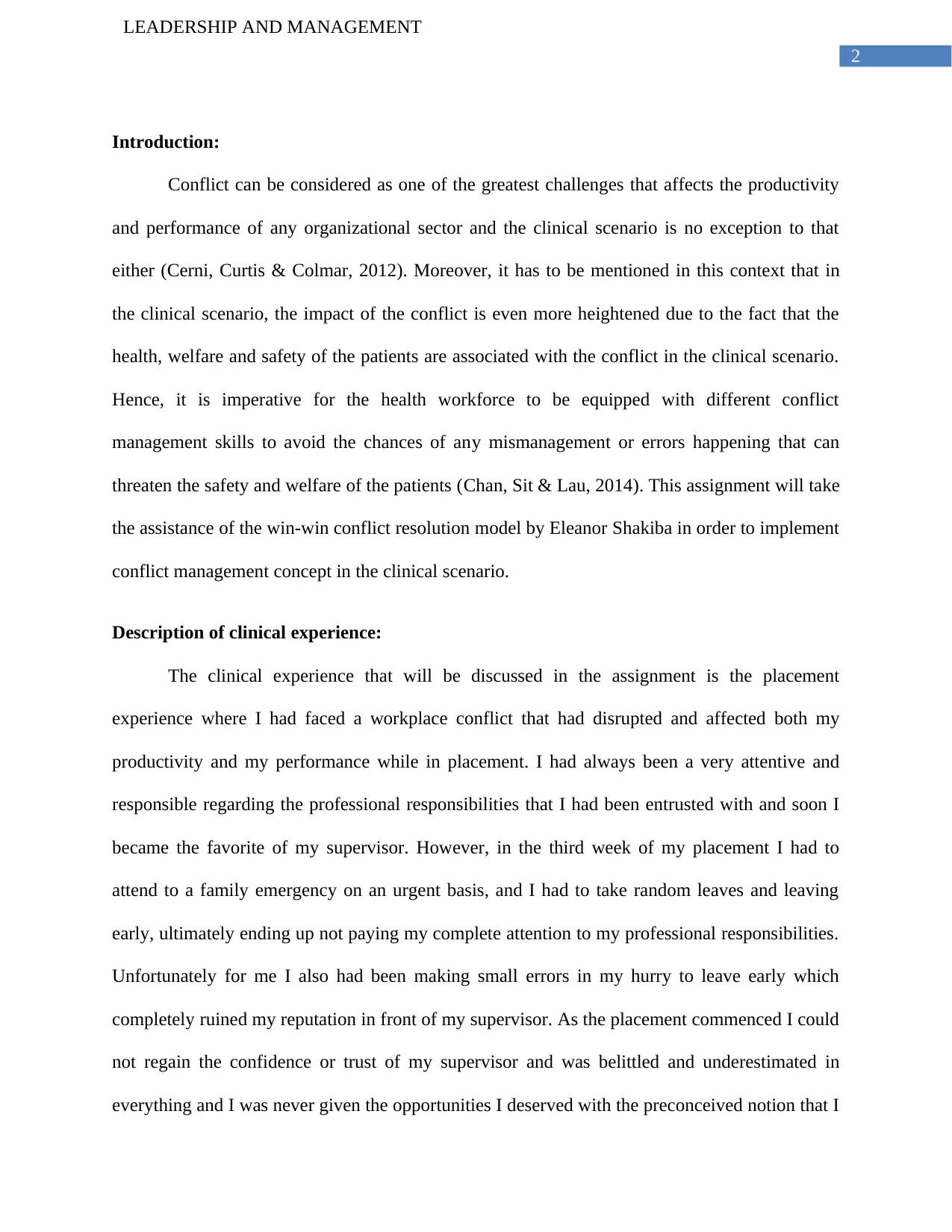
2
LEADERSHIP AND MANAGEMENT
Introduction:
Conflict can be considered as one of the greatest challenges that affects the productivity
and performance of any organizational sector and the clinical scenario is no exception to that
either (Cerni, Curtis & Colmar, 2012). Moreover, it has to be mentioned in this context that in
the clinical scenario, the impact of the conflict is even more heightened due to the fact that the
health, welfare and safety of the patients are associated with the conflict in the clinical scenario.
Hence, it is imperative for the health workforce to be equipped with different conflict
management skills to avoid the chances of any mismanagement or errors happening that can
threaten the safety and welfare of the patients (Chan, Sit & Lau, 2014). This assignment will take
the assistance of the win-win conflict resolution model by Eleanor Shakiba in order to implement
conflict management concept in the clinical scenario.
Description of clinical experience:
The clinical experience that will be discussed in the assignment is the placement
experience where I had faced a workplace conflict that had disrupted and affected both my
productivity and my performance while in placement. I had always been a very attentive and
responsible regarding the professional responsibilities that I had been entrusted with and soon I
became the favorite of my supervisor. However, in the third week of my placement I had to
attend to a family emergency on an urgent basis, and I had to take random leaves and leaving
early, ultimately ending up not paying my complete attention to my professional responsibilities.
Unfortunately for me I also had been making small errors in my hurry to leave early which
completely ruined my reputation in front of my supervisor. As the placement commenced I could
not regain the confidence or trust of my supervisor and was belittled and underestimated in
everything and I was never given the opportunities I deserved with the preconceived notion that I
LEADERSHIP AND MANAGEMENT
Introduction:
Conflict can be considered as one of the greatest challenges that affects the productivity
and performance of any organizational sector and the clinical scenario is no exception to that
either (Cerni, Curtis & Colmar, 2012). Moreover, it has to be mentioned in this context that in
the clinical scenario, the impact of the conflict is even more heightened due to the fact that the
health, welfare and safety of the patients are associated with the conflict in the clinical scenario.
Hence, it is imperative for the health workforce to be equipped with different conflict
management skills to avoid the chances of any mismanagement or errors happening that can
threaten the safety and welfare of the patients (Chan, Sit & Lau, 2014). This assignment will take
the assistance of the win-win conflict resolution model by Eleanor Shakiba in order to implement
conflict management concept in the clinical scenario.
Description of clinical experience:
The clinical experience that will be discussed in the assignment is the placement
experience where I had faced a workplace conflict that had disrupted and affected both my
productivity and my performance while in placement. I had always been a very attentive and
responsible regarding the professional responsibilities that I had been entrusted with and soon I
became the favorite of my supervisor. However, in the third week of my placement I had to
attend to a family emergency on an urgent basis, and I had to take random leaves and leaving
early, ultimately ending up not paying my complete attention to my professional responsibilities.
Unfortunately for me I also had been making small errors in my hurry to leave early which
completely ruined my reputation in front of my supervisor. As the placement commenced I could
not regain the confidence or trust of my supervisor and was belittled and underestimated in
everything and I was never given the opportunities I deserved with the preconceived notion that I
⊘ This is a preview!⊘
Do you want full access?
Subscribe today to unlock all pages.

Trusted by 1+ million students worldwide
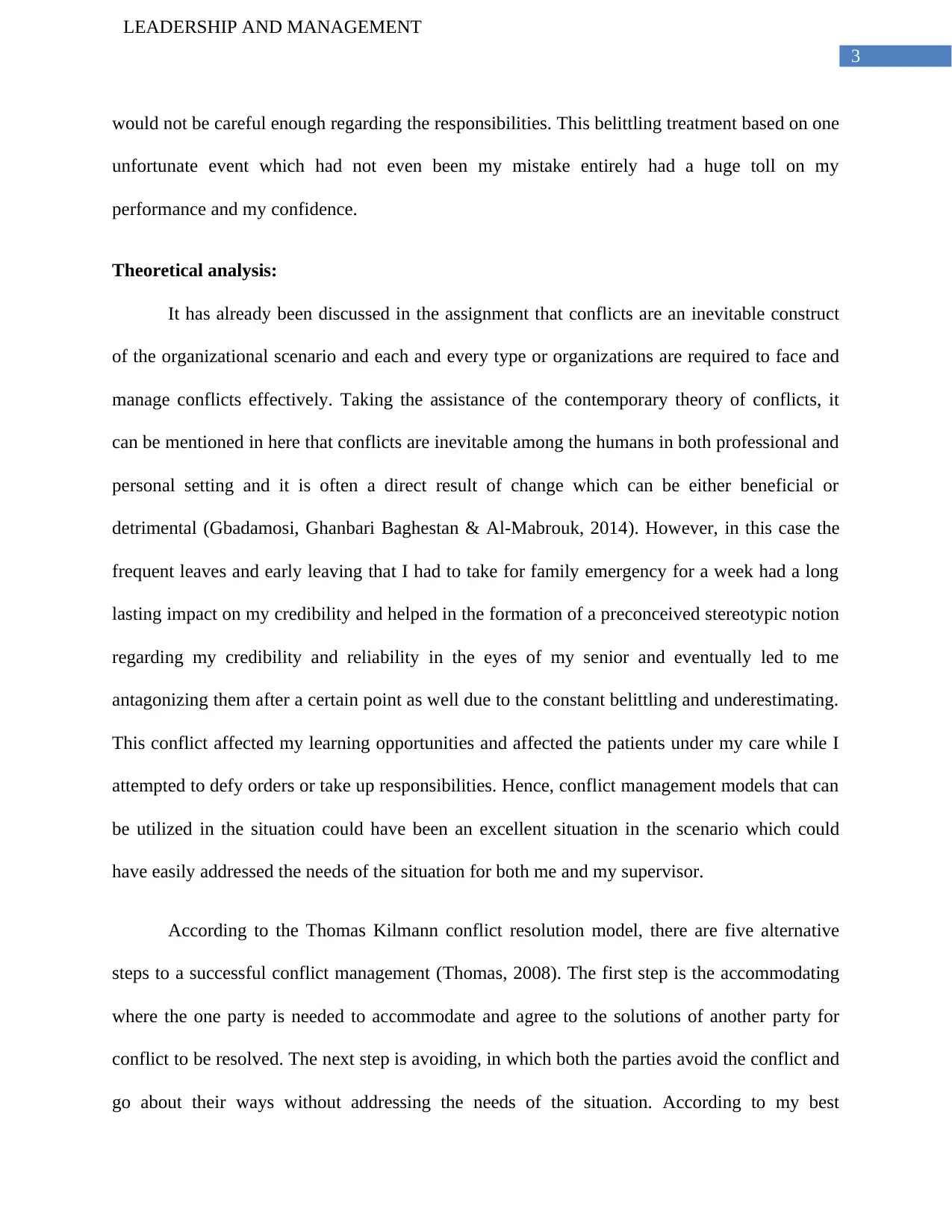
3
LEADERSHIP AND MANAGEMENT
would not be careful enough regarding the responsibilities. This belittling treatment based on one
unfortunate event which had not even been my mistake entirely had a huge toll on my
performance and my confidence.
Theoretical analysis:
It has already been discussed in the assignment that conflicts are an inevitable construct
of the organizational scenario and each and every type or organizations are required to face and
manage conflicts effectively. Taking the assistance of the contemporary theory of conflicts, it
can be mentioned in here that conflicts are inevitable among the humans in both professional and
personal setting and it is often a direct result of change which can be either beneficial or
detrimental (Gbadamosi, Ghanbari Baghestan & Al-Mabrouk, 2014). However, in this case the
frequent leaves and early leaving that I had to take for family emergency for a week had a long
lasting impact on my credibility and helped in the formation of a preconceived stereotypic notion
regarding my credibility and reliability in the eyes of my senior and eventually led to me
antagonizing them after a certain point as well due to the constant belittling and underestimating.
This conflict affected my learning opportunities and affected the patients under my care while I
attempted to defy orders or take up responsibilities. Hence, conflict management models that can
be utilized in the situation could have been an excellent situation in the scenario which could
have easily addressed the needs of the situation for both me and my supervisor.
According to the Thomas Kilmann conflict resolution model, there are five alternative
steps to a successful conflict management (Thomas, 2008). The first step is the accommodating
where the one party is needed to accommodate and agree to the solutions of another party for
conflict to be resolved. The next step is avoiding, in which both the parties avoid the conflict and
go about their ways without addressing the needs of the situation. According to my best
LEADERSHIP AND MANAGEMENT
would not be careful enough regarding the responsibilities. This belittling treatment based on one
unfortunate event which had not even been my mistake entirely had a huge toll on my
performance and my confidence.
Theoretical analysis:
It has already been discussed in the assignment that conflicts are an inevitable construct
of the organizational scenario and each and every type or organizations are required to face and
manage conflicts effectively. Taking the assistance of the contemporary theory of conflicts, it
can be mentioned in here that conflicts are inevitable among the humans in both professional and
personal setting and it is often a direct result of change which can be either beneficial or
detrimental (Gbadamosi, Ghanbari Baghestan & Al-Mabrouk, 2014). However, in this case the
frequent leaves and early leaving that I had to take for family emergency for a week had a long
lasting impact on my credibility and helped in the formation of a preconceived stereotypic notion
regarding my credibility and reliability in the eyes of my senior and eventually led to me
antagonizing them after a certain point as well due to the constant belittling and underestimating.
This conflict affected my learning opportunities and affected the patients under my care while I
attempted to defy orders or take up responsibilities. Hence, conflict management models that can
be utilized in the situation could have been an excellent situation in the scenario which could
have easily addressed the needs of the situation for both me and my supervisor.
According to the Thomas Kilmann conflict resolution model, there are five alternative
steps to a successful conflict management (Thomas, 2008). The first step is the accommodating
where the one party is needed to accommodate and agree to the solutions of another party for
conflict to be resolved. The next step is avoiding, in which both the parties avoid the conflict and
go about their ways without addressing the needs of the situation. According to my best
Paraphrase This Document
Need a fresh take? Get an instant paraphrase of this document with our AI Paraphraser
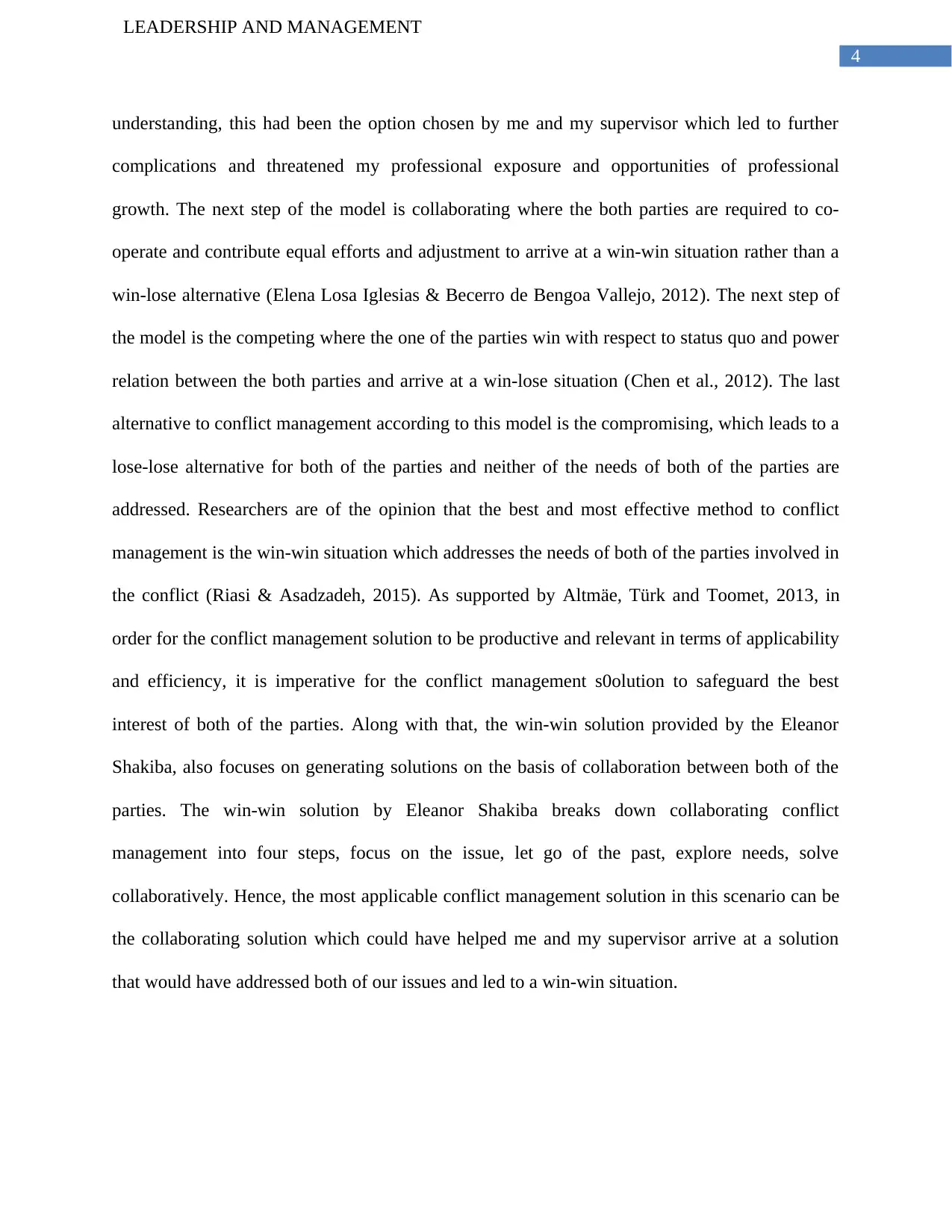
4
LEADERSHIP AND MANAGEMENT
understanding, this had been the option chosen by me and my supervisor which led to further
complications and threatened my professional exposure and opportunities of professional
growth. The next step of the model is collaborating where the both parties are required to co-
operate and contribute equal efforts and adjustment to arrive at a win-win situation rather than a
win-lose alternative (Elena Losa Iglesias & Becerro de Bengoa Vallejo, 2012). The next step of
the model is the competing where the one of the parties win with respect to status quo and power
relation between the both parties and arrive at a win-lose situation (Chen et al., 2012). The last
alternative to conflict management according to this model is the compromising, which leads to a
lose-lose alternative for both of the parties and neither of the needs of both of the parties are
addressed. Researchers are of the opinion that the best and most effective method to conflict
management is the win-win situation which addresses the needs of both of the parties involved in
the conflict (Riasi & Asadzadeh, 2015). As supported by Altmäe, Türk and Toomet, 2013, in
order for the conflict management solution to be productive and relevant in terms of applicability
and efficiency, it is imperative for the conflict management s0olution to safeguard the best
interest of both of the parties. Along with that, the win-win solution provided by the Eleanor
Shakiba, also focuses on generating solutions on the basis of collaboration between both of the
parties. The win-win solution by Eleanor Shakiba breaks down collaborating conflict
management into four steps, focus on the issue, let go of the past, explore needs, solve
collaboratively. Hence, the most applicable conflict management solution in this scenario can be
the collaborating solution which could have helped me and my supervisor arrive at a solution
that would have addressed both of our issues and led to a win-win situation.
LEADERSHIP AND MANAGEMENT
understanding, this had been the option chosen by me and my supervisor which led to further
complications and threatened my professional exposure and opportunities of professional
growth. The next step of the model is collaborating where the both parties are required to co-
operate and contribute equal efforts and adjustment to arrive at a win-win situation rather than a
win-lose alternative (Elena Losa Iglesias & Becerro de Bengoa Vallejo, 2012). The next step of
the model is the competing where the one of the parties win with respect to status quo and power
relation between the both parties and arrive at a win-lose situation (Chen et al., 2012). The last
alternative to conflict management according to this model is the compromising, which leads to a
lose-lose alternative for both of the parties and neither of the needs of both of the parties are
addressed. Researchers are of the opinion that the best and most effective method to conflict
management is the win-win situation which addresses the needs of both of the parties involved in
the conflict (Riasi & Asadzadeh, 2015). As supported by Altmäe, Türk and Toomet, 2013, in
order for the conflict management solution to be productive and relevant in terms of applicability
and efficiency, it is imperative for the conflict management s0olution to safeguard the best
interest of both of the parties. Along with that, the win-win solution provided by the Eleanor
Shakiba, also focuses on generating solutions on the basis of collaboration between both of the
parties. The win-win solution by Eleanor Shakiba breaks down collaborating conflict
management into four steps, focus on the issue, let go of the past, explore needs, solve
collaboratively. Hence, the most applicable conflict management solution in this scenario can be
the collaborating solution which could have helped me and my supervisor arrive at a solution
that would have addressed both of our issues and led to a win-win situation.
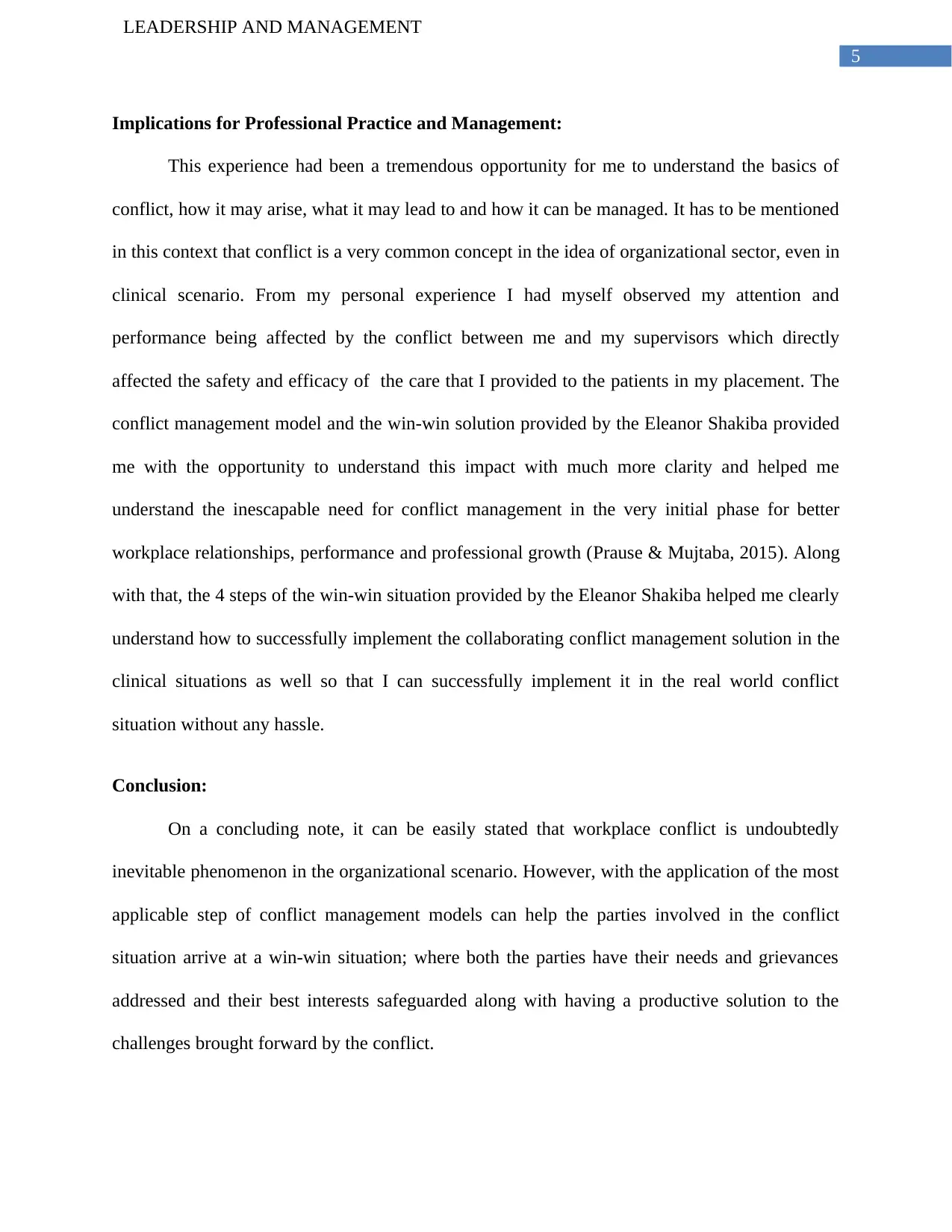
5
LEADERSHIP AND MANAGEMENT
Implications for Professional Practice and Management:
This experience had been a tremendous opportunity for me to understand the basics of
conflict, how it may arise, what it may lead to and how it can be managed. It has to be mentioned
in this context that conflict is a very common concept in the idea of organizational sector, even in
clinical scenario. From my personal experience I had myself observed my attention and
performance being affected by the conflict between me and my supervisors which directly
affected the safety and efficacy of the care that I provided to the patients in my placement. The
conflict management model and the win-win solution provided by the Eleanor Shakiba provided
me with the opportunity to understand this impact with much more clarity and helped me
understand the inescapable need for conflict management in the very initial phase for better
workplace relationships, performance and professional growth (Prause & Mujtaba, 2015). Along
with that, the 4 steps of the win-win situation provided by the Eleanor Shakiba helped me clearly
understand how to successfully implement the collaborating conflict management solution in the
clinical situations as well so that I can successfully implement it in the real world conflict
situation without any hassle.
Conclusion:
On a concluding note, it can be easily stated that workplace conflict is undoubtedly
inevitable phenomenon in the organizational scenario. However, with the application of the most
applicable step of conflict management models can help the parties involved in the conflict
situation arrive at a win-win situation; where both the parties have their needs and grievances
addressed and their best interests safeguarded along with having a productive solution to the
challenges brought forward by the conflict.
LEADERSHIP AND MANAGEMENT
Implications for Professional Practice and Management:
This experience had been a tremendous opportunity for me to understand the basics of
conflict, how it may arise, what it may lead to and how it can be managed. It has to be mentioned
in this context that conflict is a very common concept in the idea of organizational sector, even in
clinical scenario. From my personal experience I had myself observed my attention and
performance being affected by the conflict between me and my supervisors which directly
affected the safety and efficacy of the care that I provided to the patients in my placement. The
conflict management model and the win-win solution provided by the Eleanor Shakiba provided
me with the opportunity to understand this impact with much more clarity and helped me
understand the inescapable need for conflict management in the very initial phase for better
workplace relationships, performance and professional growth (Prause & Mujtaba, 2015). Along
with that, the 4 steps of the win-win situation provided by the Eleanor Shakiba helped me clearly
understand how to successfully implement the collaborating conflict management solution in the
clinical situations as well so that I can successfully implement it in the real world conflict
situation without any hassle.
Conclusion:
On a concluding note, it can be easily stated that workplace conflict is undoubtedly
inevitable phenomenon in the organizational scenario. However, with the application of the most
applicable step of conflict management models can help the parties involved in the conflict
situation arrive at a win-win situation; where both the parties have their needs and grievances
addressed and their best interests safeguarded along with having a productive solution to the
challenges brought forward by the conflict.
⊘ This is a preview!⊘
Do you want full access?
Subscribe today to unlock all pages.

Trusted by 1+ million students worldwide
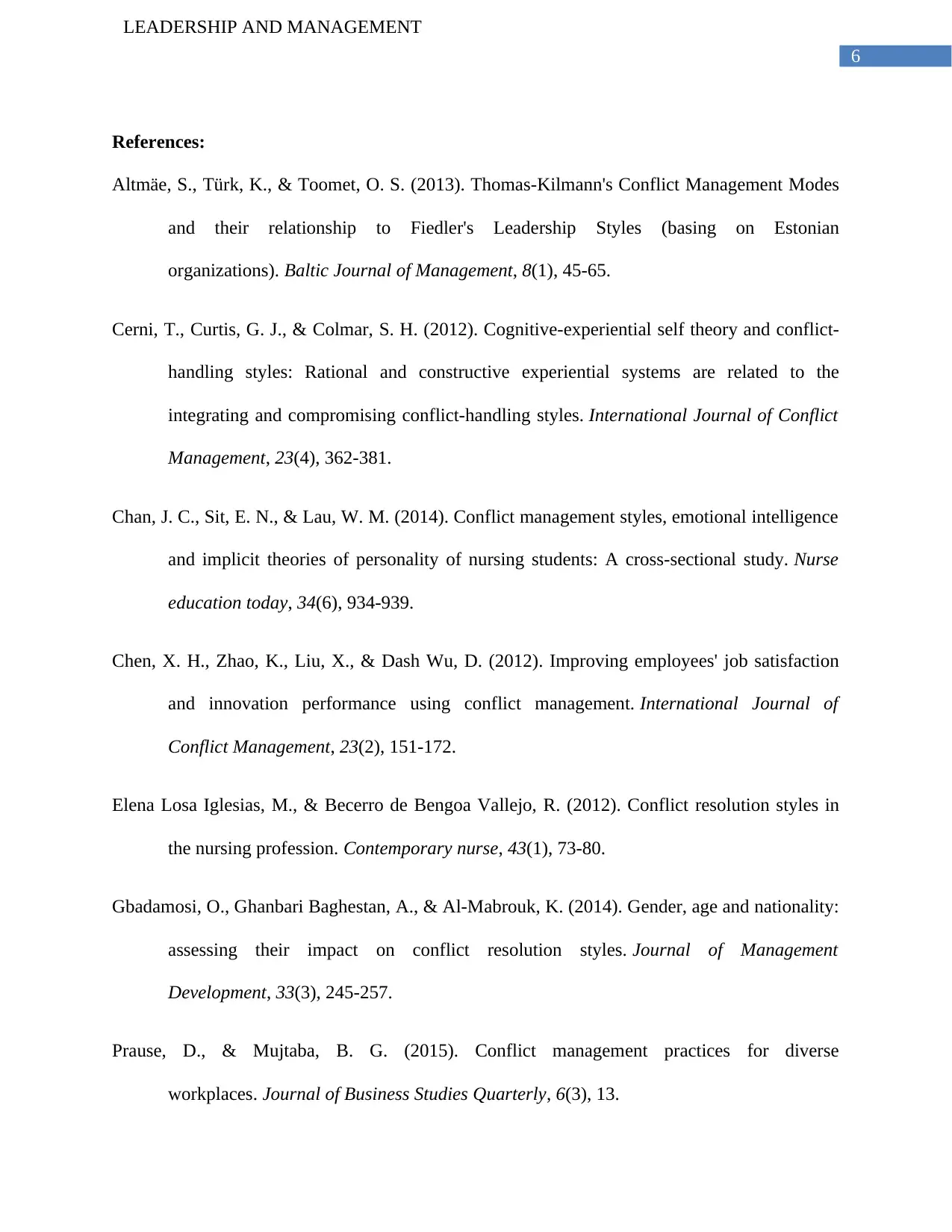
6
LEADERSHIP AND MANAGEMENT
References:
Altmäe, S., Türk, K., & Toomet, O. S. (2013). Thomas-Kilmann's Conflict Management Modes
and their relationship to Fiedler's Leadership Styles (basing on Estonian
organizations). Baltic Journal of Management, 8(1), 45-65.
Cerni, T., Curtis, G. J., & Colmar, S. H. (2012). Cognitive-experiential self theory and conflict-
handling styles: Rational and constructive experiential systems are related to the
integrating and compromising conflict-handling styles. International Journal of Conflict
Management, 23(4), 362-381.
Chan, J. C., Sit, E. N., & Lau, W. M. (2014). Conflict management styles, emotional intelligence
and implicit theories of personality of nursing students: A cross-sectional study. Nurse
education today, 34(6), 934-939.
Chen, X. H., Zhao, K., Liu, X., & Dash Wu, D. (2012). Improving employees' job satisfaction
and innovation performance using conflict management. International Journal of
Conflict Management, 23(2), 151-172.
Elena Losa Iglesias, M., & Becerro de Bengoa Vallejo, R. (2012). Conflict resolution styles in
the nursing profession. Contemporary nurse, 43(1), 73-80.
Gbadamosi, O., Ghanbari Baghestan, A., & Al-Mabrouk, K. (2014). Gender, age and nationality:
assessing their impact on conflict resolution styles. Journal of Management
Development, 33(3), 245-257.
Prause, D., & Mujtaba, B. G. (2015). Conflict management practices for diverse
workplaces. Journal of Business Studies Quarterly, 6(3), 13.
LEADERSHIP AND MANAGEMENT
References:
Altmäe, S., Türk, K., & Toomet, O. S. (2013). Thomas-Kilmann's Conflict Management Modes
and their relationship to Fiedler's Leadership Styles (basing on Estonian
organizations). Baltic Journal of Management, 8(1), 45-65.
Cerni, T., Curtis, G. J., & Colmar, S. H. (2012). Cognitive-experiential self theory and conflict-
handling styles: Rational and constructive experiential systems are related to the
integrating and compromising conflict-handling styles. International Journal of Conflict
Management, 23(4), 362-381.
Chan, J. C., Sit, E. N., & Lau, W. M. (2014). Conflict management styles, emotional intelligence
and implicit theories of personality of nursing students: A cross-sectional study. Nurse
education today, 34(6), 934-939.
Chen, X. H., Zhao, K., Liu, X., & Dash Wu, D. (2012). Improving employees' job satisfaction
and innovation performance using conflict management. International Journal of
Conflict Management, 23(2), 151-172.
Elena Losa Iglesias, M., & Becerro de Bengoa Vallejo, R. (2012). Conflict resolution styles in
the nursing profession. Contemporary nurse, 43(1), 73-80.
Gbadamosi, O., Ghanbari Baghestan, A., & Al-Mabrouk, K. (2014). Gender, age and nationality:
assessing their impact on conflict resolution styles. Journal of Management
Development, 33(3), 245-257.
Prause, D., & Mujtaba, B. G. (2015). Conflict management practices for diverse
workplaces. Journal of Business Studies Quarterly, 6(3), 13.
Paraphrase This Document
Need a fresh take? Get an instant paraphrase of this document with our AI Paraphraser
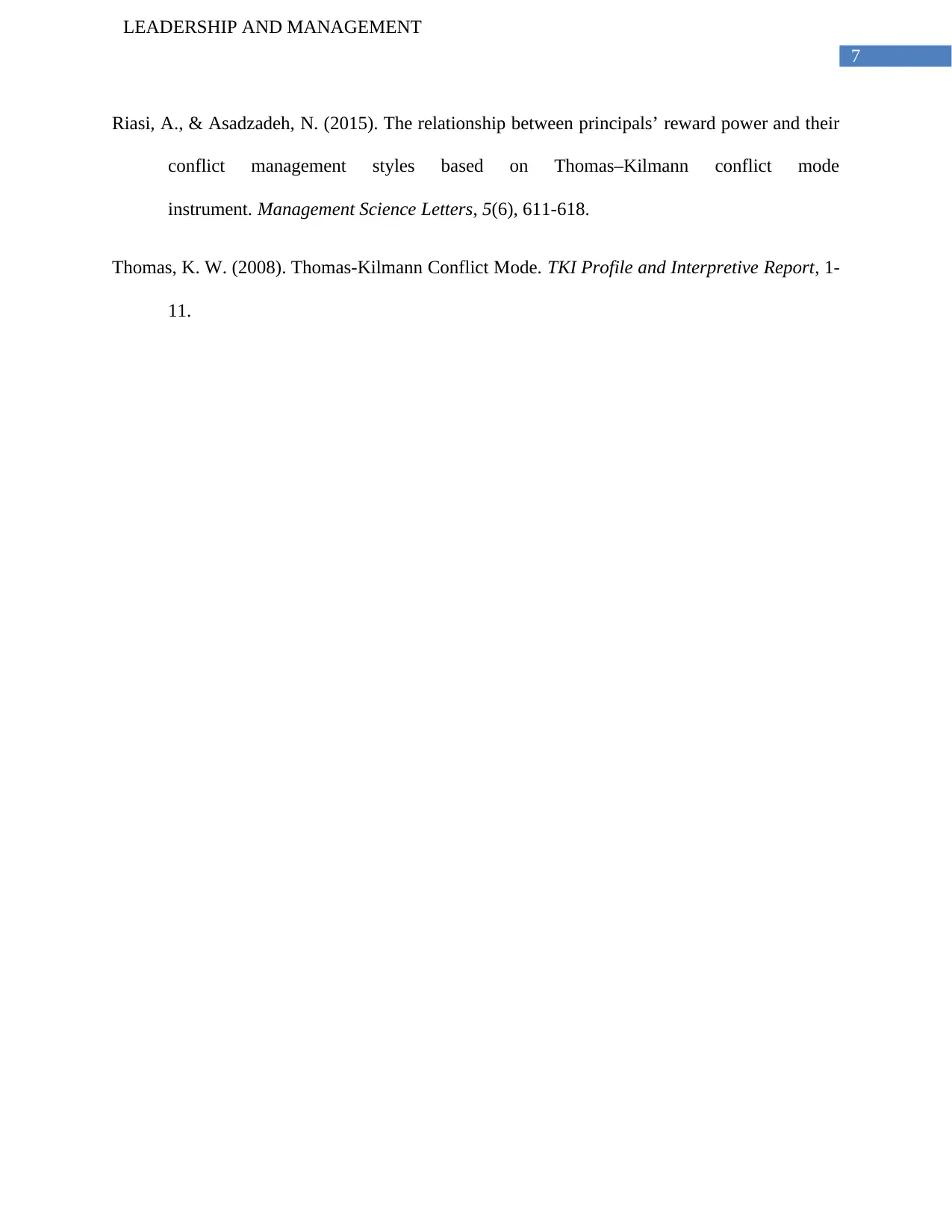
7
LEADERSHIP AND MANAGEMENT
Riasi, A., & Asadzadeh, N. (2015). The relationship between principals’ reward power and their
conflict management styles based on Thomas–Kilmann conflict mode
instrument. Management Science Letters, 5(6), 611-618.
Thomas, K. W. (2008). Thomas-Kilmann Conflict Mode. TKI Profile and Interpretive Report, 1-
11.
LEADERSHIP AND MANAGEMENT
Riasi, A., & Asadzadeh, N. (2015). The relationship between principals’ reward power and their
conflict management styles based on Thomas–Kilmann conflict mode
instrument. Management Science Letters, 5(6), 611-618.
Thomas, K. W. (2008). Thomas-Kilmann Conflict Mode. TKI Profile and Interpretive Report, 1-
11.
1 out of 8
Related Documents
Your All-in-One AI-Powered Toolkit for Academic Success.
+13062052269
info@desklib.com
Available 24*7 on WhatsApp / Email
![[object Object]](/_next/static/media/star-bottom.7253800d.svg)
Unlock your academic potential
Copyright © 2020–2025 A2Z Services. All Rights Reserved. Developed and managed by ZUCOL.



